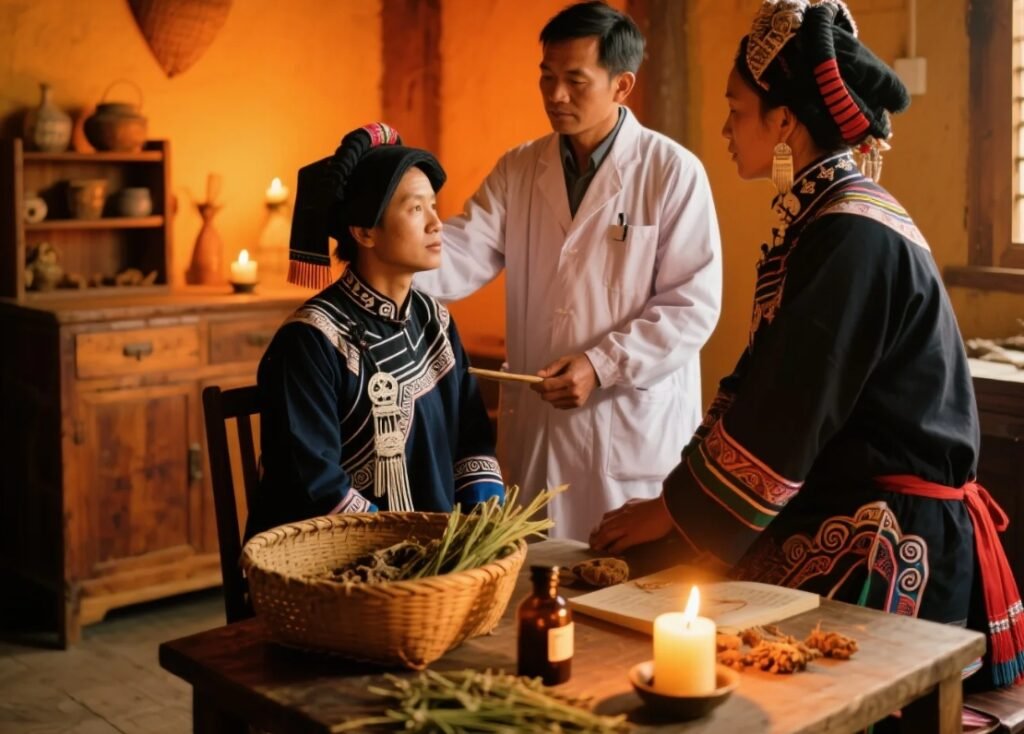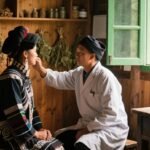Mongb jul lol eb hniangk (Sweating Disorder) in Miao Medicine
Overview
In Miao- medicine, sweating disorder is known as Mongb jul lol eb hniangk. This condition is caused by the invasion of wind toxins, water toxins, heat toxins, or damp-cold toxins into the human body.
From the perspective of Traditional Chinese Medicine (TCM), sweating disorders result from imbalances between yin and yang, and dysfunction of the skin’s protective mechanism (wei qi), leading to abnormal leakage of sweat.
In Western medicine, excessive sweating may be associated with hyperthyroidism, autonomic dysfunction, rheumatic fever, or tuberculosis, and can be analyzed through syndrome differentiation and (used in traditional contexts) similar to those in Miao -medicine.
Classification in Miao -Medicine
Mongb jul lol eb hniangk is considered a minor syndrome and is divided into two primary types: cold sweating and hot sweating. Cold sweating includes qi-deficiency sweating and blood-deficiency sweating, while hot sweating includes deficiency-heat sweating and heat-toxin sweating—a total of four subtypes.
Cause
Miao -medicine emphasizes that toxins are the primary cause of disease. Toxins are widespread and diverse. This concept led to the Miao theory of “the Four Major Toxins”: wind toxin, water toxin, heat toxin, and damp toxin. Sweating disorders are often triggered by the invasion of these toxic elements into the human body.
Pathogenesis
Once these toxins invade the body, they cause damage to qi, blood, and body fluids. If blood is injured by heat, it leads to profuse sweating. Damage to qi alone causes qi-deficiency cold sweat. Because qi and blood are interrelated in Miao theory, blood deficiency also results in qi deficiency, which can cause night sweating. Blood deficiency alone can also lead to night sweats.
Diagnostic Essentials
Diagnosis Criteria:
Spontaneous sweating without external triggers, often occurring on the face, neck, chest, limbs, or the entire body. Sweating that worsens with movement during the day is considered spontaneous sweating; night sweating that stops upon waking is known as night sweat.
Exclude sweating caused by other known medical conditions.

Supporting Examinations:
Useful tests include ESR (erythrocyte sedimentation rate), anti-streptolysin O (ASO), T3, T4, basal metabolism, blood glucose, chest X-ray, and sputum smear.
Differentiation
Cold Sweating (Seil hniangk)
Includes qi-deficiency sweating and blood-deficiency sweating. Both belong to cold-type syndromes.
Qi-deficiency sweating often comes with fear of wind, localized sweating, and susceptibility to colds.
Blood-deficiency sweating is accompanied by palpitations, chest tightness, and general fatigue.
Hot Sweating (Tob hniangk)
Includes deficiency-heat sweating and heat-toxin sweating.
Both subtypes present with fever and irritability.
Deficiency-heat sweating occurs at night, usually with low-grade fever, and is due to internal depletion.
Heat-toxin sweating is associated with high fever, thick sweat, and symptoms of internal heat.
Syndrome Classification and Treatment
1. Cold Sweating
(1) Qi-Deficiency Sweating
Symptoms: Spontaneous sweating, fear of wind, chills, worsens with movement, partial or unilateral sweating, body pain, pale complexion.
Syndrome Type: Cold meridian, cold disorder.
Treatment Principle: Tonify qi and blood, strengthen spleen and stomach.
Herbal Formula:
Glutinous rice root + galaodangga – 20g
Dioscorea opposita + shanyao – 20g
Rabdosia rubescens + yehansu – 20g
Polygonatum sibiricum + huangjing – 20g
Decoction for oral administration.
(2) Blood-Deficiency Sweating
Symptoms: Spontaneous sweating, pale complexion, palpitations, chest tightness, poor sleep, shortness of breath, fatigue, reduced appetite, clear urine.
Syndrome Type: Cold meridian, cold disorder.
Treatment Principle: Tonify qi and yin, nourish stomach and generate fluids.
Herbal Formula:
Codonopsis pilosula + dangshen – 20g
Polygonum multiflorum stem + shouwuteng – 15g
Glutinous rice root + galaodangga – 20g
Nymphaea tetragona + shuilian – 15g
Rosa laevigata fruit + jinyingzi – 12g
Decoction for oral use.
2. Hot Sweating
(1) Deficiency-Heat Sweating
Symptoms: Spontaneous and night sweating, hot palms and soles, afternoon low-grade fever, facial flushing, thirst.
Syndrome Type: Cold meridian, cold disorder.
Treatment Principle: Nourish yin, clear internal fire, tonify qi and blood.
Herbal Formula:
Panax japonicus + xueren shen – 20g
Lilium brownii + baihe – 15g
Prunus mume + wumei – 20g
Lyonia ovalifolia + shichuanlian – 20g
Decoction for oral use.
(2) Heat-Toxin Sweating
Symptoms: High fever, profuse and sticky sweat, flushed face, irritability, bitter mouth, yellow and scanty urine.
Syndrome Type: Hot meridian, hot disorder.
Treatment Principle: Nourish yin, reduce fire, replenish qi and fluids.
Herbal Formula:
Gentiana scabra + longdancao – 15g
Paeonia lactiflora + baishao – 15g
Poria cocos + fuling – 20g
Boil for oral administration.
Preventive Care
After sweating, the skin’s pores are open and vulnerable to external pathogens. Avoid exposure to wind and cold. Always dry off sweat immediately to (helps maintain) catching a cold.
For those who sweat profusely, change clothing often and maintain dry, clean clothes and bedding.
Commentary
In Miao- medicine, sweating disorders are closely related to the body’s sweat pores (sweat caves), which are governed by brain qi and protective energy (hui qi). When the body is invaded by the Four Major Toxins, the regulation of sweat pores becomes disrupted. As a result, the pores may open abnormally, leading to pathological sweating.
Sweating disorders are categorized into cold and hot types, both involving abnormal perspiration. Differentiating the type is key to effective (used in traditional contexts):
Cold sweating is treated by reinforcing vital energy and stopping excessive sweating.
Hot sweating includes both deficiency-heat and heat-toxin types, requiring different approaches:
Deficiency-heat sweating is treated by nourishing yin and reducing internal heat while replenishing qi and blood.
Heat-toxin sweating is treated by clearing fire, nourishing yin, and restoring balance.


Leave a Reply